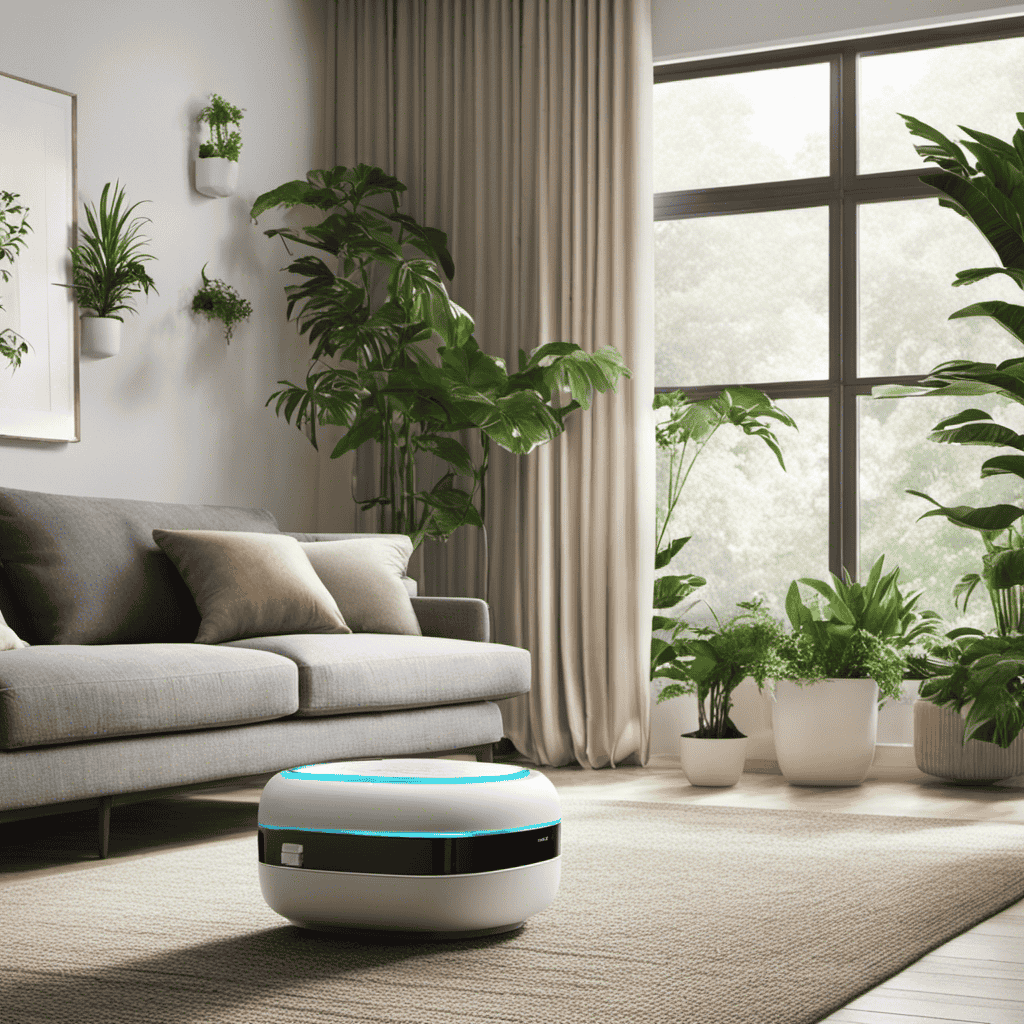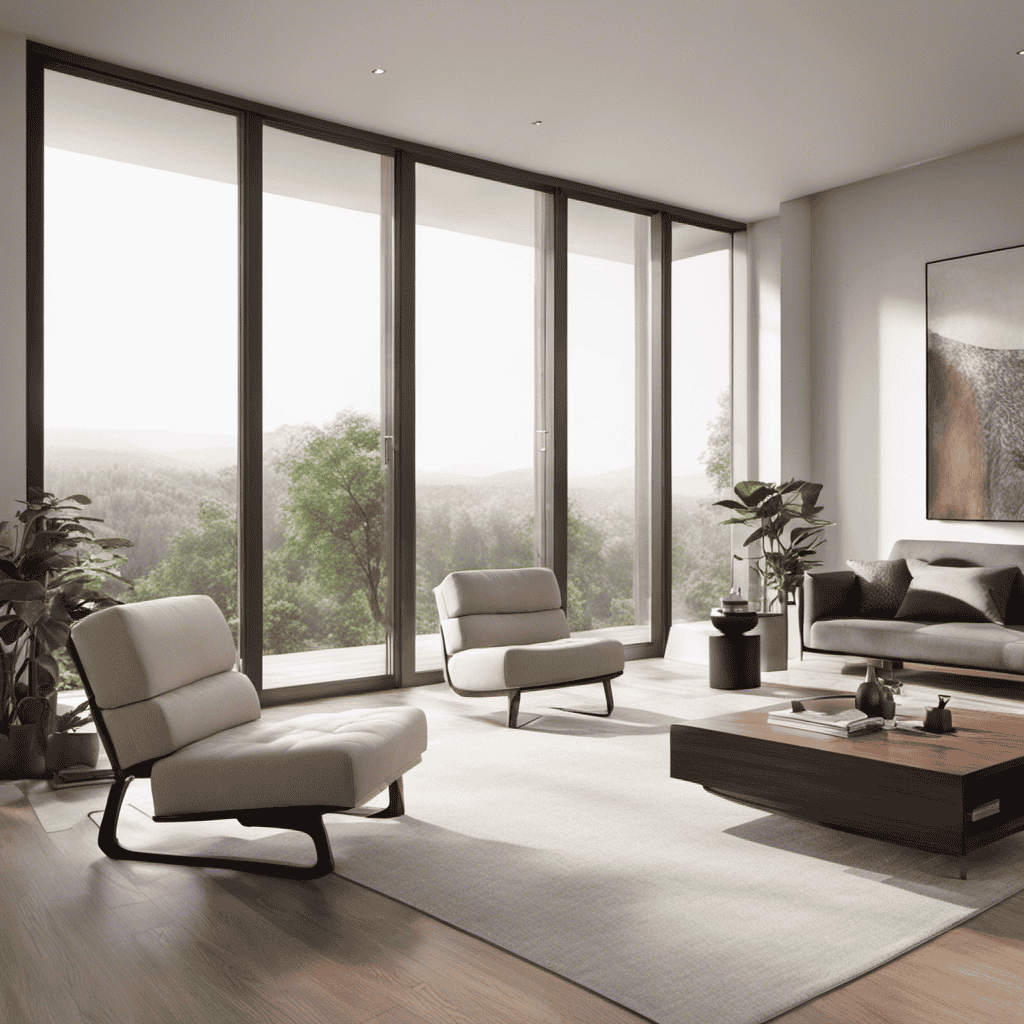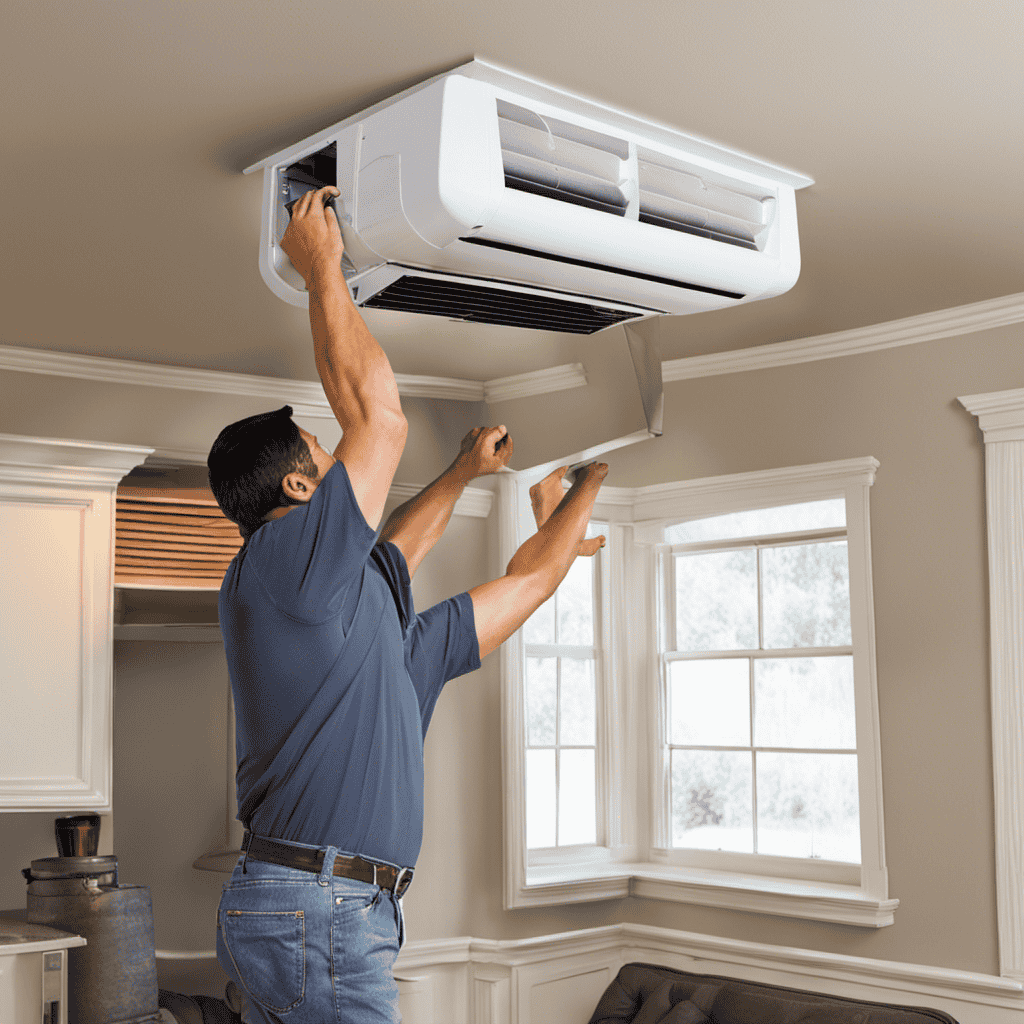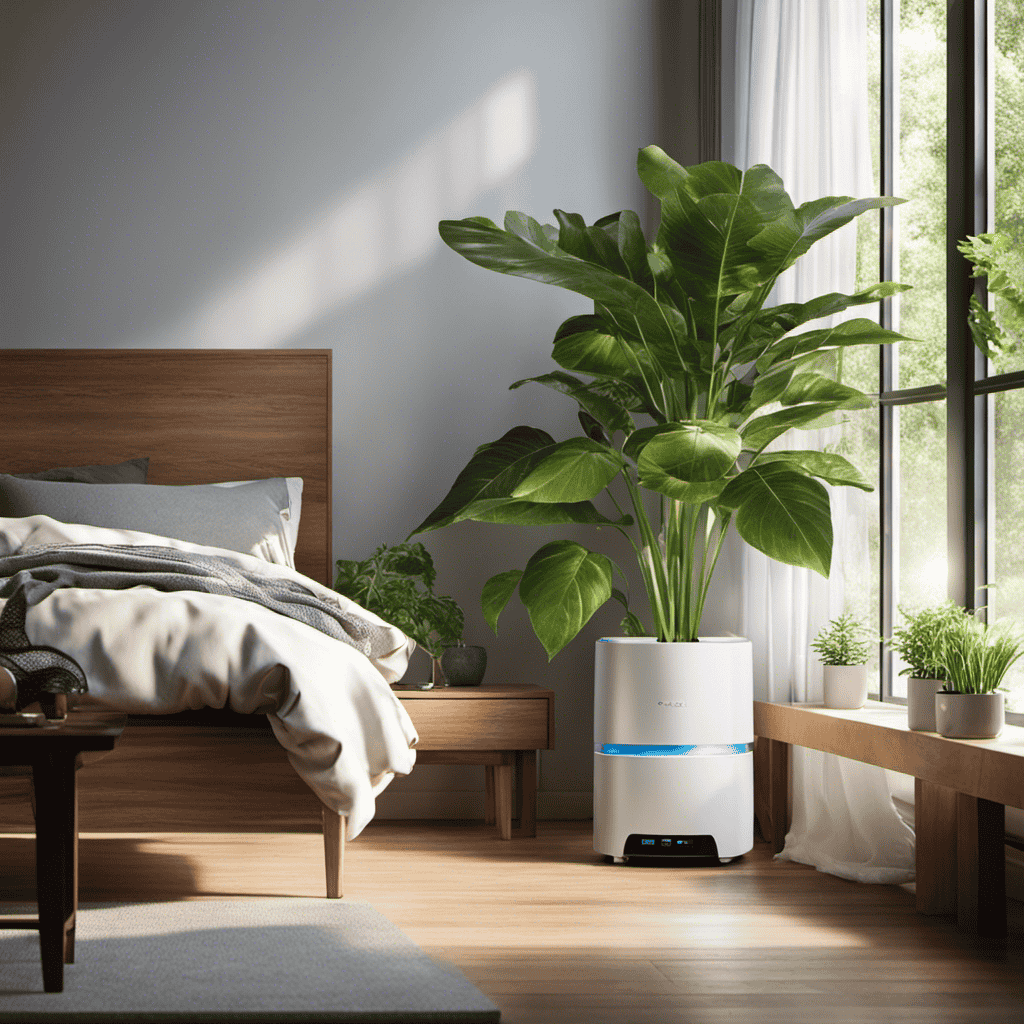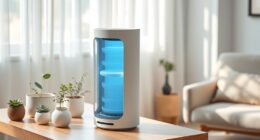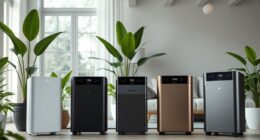As a fan of air purifiers, I have frequently pondered if the location of my air purifier truly makes a difference. Can where I place it impact how well it works?
In this article, we will delve into the world of air purifier placement and explore the impact it can have on improving indoor air quality.
From bedrooms to living spaces, home offices to kitchens, and even outdoor placement considerations, we will uncover the best practices and common mistakes to ensure you make the most of your air purifier investment.
Key Takeaways
- Proper placement of an air purifier is essential for its effectiveness in improving indoor air quality.
- Ideal placement locations include near the center of the room, away from obstructions, and in areas with good air flow.
- Placement considerations include avoiding corners or behind large objects, keeping a distance from walls, and choosing areas where it won’t be easily bumped or blocked by furniture.
- Placement can also impact the noise level of an air purifier, so it’s important to consider stability, foot traffic, and reverberation when deciding on placement.
The Importance of Placement
It’s important to consider where you place your air purifier. The placement of your air purifier can have a significant impact on its effectiveness in improving bedroom air quality and office productivity.
When it comes to your bedroom, placing the air purifier near your bed can help ensure that you breathe in clean and purified air throughout the night. This can lead to improved sleep quality and overall health.
In an office setting, positioning the air purifier near your workspace can help remove airborne pollutants and allergens, creating a healthier and more productive environment. Studies have shown that improved indoor air quality can lead to a reduction in sick days and an increase in employee productivity.
Therefore, by carefully considering the placement of your air purifier, you can optimize its benefits and create a healthier and more productive space.
Considerations for Bedroom Placement
For optimal effectiveness, consider placing your air purifier in your bedroom. The bedroom is where we spend a significant amount of time, sleeping and resting. It is important to prioritize the quality of the air we breathe in this space.
Bedroom air quality can be affected by factors such as dust, allergens, and pet dander. By placing an air purifier in your bedroom, you can effectively remove these pollutants and improve the air you breathe while you sleep.
Additionally, noise level considerations are crucial in the bedroom. Look for air purifiers that operate quietly, ensuring a peaceful and uninterrupted sleep.
Now, let’s explore the best locations for placing air purifiers in other living spaces.
Best Locations in Living Spaces
Consider placing an air purifier in the living room, where I spend a significant amount of time relaxing and entertaining guests. The living room is a central area in the house, and having an air purifier in this space can improve indoor air quality for everyone.
Air purifiers are designed to remove particles and pollutants from the air, such as dust, pet dander, and pollen. By placing an air purifier in the living room, I can ensure that the air my guests and I breathe is clean and healthy.
Additionally, if I have a bedroom air purifier and an office air purifier, having one in the living room completes the air filtration system for the entire living space.
It is important to choose an air purifier that is suitable for the size of the living room and has the necessary filtration capabilities to effectively clean the air.
Ideal Placement for Home Offices
When it comes to setting up a home office, two key considerations that should not be overlooked are optimal air circulation and reducing pollutant exposure.
Proper air circulation ensures that fresh, clean air is constantly flowing through the workspace, promoting better concentration and productivity.
Additionally, reducing pollutant exposure is crucial for maintaining a healthy work environment, as it can help prevent respiratory issues and other health problems.
Optimal Air Circulation
To ensure optimal air circulation, make sure you place your air purifier in a central location within the room. This strategic placement allows for maximum coverage and efficient removal of airborne pollutants.
When it comes to air purifier maintenance, proper placement is crucial. Placing the device near walls or furniture can obstruct the airflow, reducing its effectiveness. By centrally locating the air purifier, you can ensure that the clean air is evenly distributed throughout the room, providing a healthier indoor environment.
It is important to note that while air purifiers are beneficial for removing pollutants, they may have an impact on indoor plants. Some air purifiers emit ozone, which can be harmful to certain plant species. Therefore, it is recommended to choose an air purifier that does not emit ozone or to keep it at a safe distance from your indoor plants.
Reducing Pollutant Exposure
If you want to reduce your exposure to pollutants, try keeping your windows closed and using an air purifier.
Indoor air quality is an important factor in maintaining good health, especially in spaces where you spend a significant amount of time, such as your bedroom or workplace.
Air purifiers are designed to remove harmful particles from the air, improving the overall air quality. By trapping pollutants like dust, pollen, and pet dander, air purifiers can help alleviate symptoms associated with allergies and asthma.
Additionally, air purifiers can be effective in reducing workplace air pollution, which is often caused by chemicals, fumes, and other airborne contaminants. They provide a constant source of clean air, making your environment healthier and more comfortable.
Now, let’s explore the impact of kitchen placement on air purifier effectiveness.
The Impact of Kitchen Placement
As a homeowner, I’ve found that the placement of an air purifier in relation to cooking fumes can greatly impact its effectiveness.
When the air purifier is located in close proximity to the kitchen, it’s able to quickly capture and remove the fumes before they spread throughout the house.
Additionally, the effectiveness of air circulation in the room where the air purifier is placed plays a crucial role in its ability to filter out cooking odors and pollutants.
Proximity to Cooking Fumes
Having an air purifier near the kitchen can help in reducing the impact of cooking fumes on indoor air quality. Cooking fumes can release harmful pollutants such as volatile organic compounds (VOCs) and particulate matter (PM) into the air. These pollutants can contribute to poor indoor air quality and have adverse effects on our health.
By placing an air purifier near the kitchen, it can effectively capture and filter out these cooking fumes, improving the overall air quality in the surrounding area. The air purifier’s filters, such as activated carbon and HEPA filters, can efficiently trap and remove these pollutants, ensuring that the air we breathe is cleaner and healthier.
Therefore, positioning the air purifier strategically near the kitchen can play a crucial role in maintaining good indoor air quality.
Air Circulation Effectiveness
Positioning an air purifier near the kitchen can improve the effectiveness of air circulation. Placing the air purifier in close proximity to the kitchen allows it to capture and filter out cooking-related particles and odors more efficiently.
This is particularly important because cooking activities can release various pollutants, such as volatile organic compounds (VOCs) and fine particulate matter (PM2.5), which can negatively impact indoor air quality.
To ensure optimal performance and longevity of the air purifier, regular maintenance is crucial. This includes cleaning or replacing filters according to the manufacturer’s instructions and keeping the unit away from potential sources of obstruction.
When choosing the right air purifier for your kitchen, consider factors such as the size of the room, the specific pollutants you want to target, and the desired features, such as activated carbon filters for odor removal or HEPA filters for particle capture.
The Benefits of Basement Placement
Placing your air purifier in the basement can provide several benefits. Basements are prone to poor air quality due to limited ventilation and potential moisture issues. By placing an air purifier in this area, you can effectively improve the air quality and create a healthier living environment. Here is a table highlighting the benefits of basement placement:
| Benefits of Basement Placement | |
|---|---|
| 1. Improved basement air quality | Air purifiers can effectively remove pollutants, allergens, and odors from the air, improving the overall air quality in basements. |
| 2. Reduction of mold and mildew | Basements are susceptible to moisture, which can lead to mold and mildew growth. Air purifiers with HEPA filters can capture mold spores and prevent their spread. |
| 3. Enhanced ventilation | Air purifiers can help circulate and filter the air, providing much-needed ventilation in basements with limited airflow. |
| 4. Healthier living environment | By purifying the air in the basement, you can create a healthier living space for you and your family. |
Ensuring proper placement in children’s rooms is equally important to create a safe and clean breathing environment for them.
Ensuring Proper Placement in Children’s Rooms
When it comes to optimizing air circulation and reducing allergy symptoms, proper placement of air purifiers is crucial.
By strategically positioning the air purifier in a room, you can ensure that the air is effectively circulated and filtered, removing allergens and improving indoor air quality.
Studies have shown that placing air purifiers near areas with high air flow, such as windows or vents, can enhance their performance and provide maximum benefits for allergy sufferers.
Optimal Air Circulation
To ensure the best air circulation, it’s important to place your air purifier in a well-ventilated area. This will allow the device to efficiently filter and circulate the air in the room. Here are some key points to consider for optimal air circulation:
-
Placement: Keep the air purifier at least 3 feet away from walls or furniture to prevent obstruction of airflow. Avoid placing the device near sources of heat or direct sunlight, as this can affect its performance.
-
Filters and Maintenance: Regularly clean or replace the filters according to the manufacturer’s instructions to maintain the air purifier’s efficiency. Check the filters for any signs of damage, clogging, or discoloration, as this may indicate the need for immediate replacement.
Proper placement and regular maintenance of your air purifier are crucial for ensuring clean and healthy air in your living space. By following these guidelines, you can optimize the performance of your air purifier and enjoy improved air quality.
Reducing Allergy Symptoms
Now that we understand the importance of optimal air circulation for our air purifiers, let’s focus on reducing allergy symptoms. Allergies can be a real nuisance, causing sneezing, itching, and congestion. However, with the right air purifier and proper maintenance, we can significantly alleviate these symptoms.
When choosing an air purifier, look for one equipped with a High-Efficiency Particulate Air (HEPA) filter. This type of filter is highly effective in capturing allergens such as pollen, dust mites, and pet dander. Additionally, consider the size of the room where you plan to use the air purifier. Different models have varying coverage areas, so make sure to select one that suits your needs.
To ensure optimal performance, regular air purifier maintenance is crucial. This includes cleaning or replacing the filters as recommended by the manufacturer. By following these guidelines, you can create a healthier indoor environment and reduce allergy symptoms effectively.
| Key Considerations | Tips for Air Purifier Maintenance |
|---|---|
| HEPA Filter | – Replace filters as recommended |
| – Vacuum or dust the unit | |
| Room Size | – Choose the appropriate size |
| based on square footage |
The Effectiveness of Bathroom Placement
Make sure you don’t place your air purifier in the bathroom if you want it to effectively clean the air in other parts of your home. The bathroom is a unique environment with specific challenges when it comes to air purification.
Here are a few reasons why bathroom placement is not ideal:
-
Bathroom Ventilation: Bathrooms typically have exhaust fans or windows to remove moisture and odors. Placing an air purifier in the bathroom can interfere with the proper function of these ventilation systems.
-
Humidity Control: Bathrooms are often humid environments due to showering and bathing. Air purifiers are not designed to control humidity levels. Placing one in the bathroom may lead to decreased effectiveness in other areas, as the purifier’s resources are being used to combat high humidity.
To maximize the effectiveness of your air purifier, consider placing it in a more central location in your home, away from sources of moisture and with good air circulation.
Outdoor Placement Considerations
When placing your air purifier outside, be mindful of the weather conditions and ensure it is protected from rain and extreme temperatures. Outdoor air quality can vary greatly depending on factors such as pollution levels, pollen count, and humidity. It is important to consider these factors when deciding on the placement of your air purifier.
Rain can damage the sensitive electronic components of the device, so it is crucial to provide adequate protection, such as placing it under a roof or using a weatherproof cover. Extreme temperatures, whether hot or cold, can also affect the performance and lifespan of the purifier. Therefore, it is recommended to choose a location that offers some shade or insulation from extreme temperature fluctuations.
Placement Tips for Allergy Sufferers
To alleviate your allergies, consider placing your purifier in the room where you spend the most time. This will ensure that you are constantly breathing clean air and minimizing exposure to allergens.
When deciding on the placement of your air purifier, there are a few factors to consider:
-
Bedroom size:
-
For smaller bedrooms, a compact purifier with a lower CADR (Clean Air Delivery Rate) may be sufficient.
-
Larger bedrooms may require a more powerful purifier with a higher CADR to effectively clean the air.
-
Filter maintenance:
-
Regularly clean or replace the filters according to the manufacturer’s instructions to maintain optimal performance.
-
Consider placing the purifier in a location that is easily accessible for filter maintenance.
Common Placement Mistakes to Avoid
When it comes to placing your air purifier, there are common mistakes that should be avoided.
One of these mistakes is placing the air purifier in a bedroom that is too large for its capacity. The size of the bedroom plays a crucial role in the effectiveness of the air purifier. If the bedroom is too large, the purifier may not be able to effectively clean the air and remove allergens.
On the other hand, placing the air purifier in a bedroom that is too small can lead to excessive noise levels. Air purifiers produce noise, especially at higher fan speeds, and placing it in a small bedroom can make it more difficult to sleep or relax.
Therefore, it is important to consider the size of the bedroom and the noise level of the air purifier when determining its placement.
Does the Placement of an Air Purifier Affect Its Effectiveness?
When it comes to maximizing the effectiveness of your air purifier, proper placement is crucial. Follow these air purifier placement tips to ensure that the unit is placed in an area with good airflow and away from obstacles like furniture or curtains. This will ensure optimal performance and clean air throughout your space.
Frequently Asked Questions
How Does the Placement of an Air Purifier Affect Its Performance?
Optimal placement is crucial for maximum efficiency of an air purifier. The size of the room does impact its performance, as larger rooms may require a higher capacity purifier to effectively clean the air.
Can I Place My Air Purifier in a Small Enclosed Space, Such as a Closet?
Yes, it matters where you put your air purifier. Placing it in a small enclosed space, like a closet, may limit its effectiveness. Proper placement is crucial for optimal air purifier maintenance and reaping the benefits of clean air.
Is It Necessary to Have Multiple Air Purifiers in Different Rooms of My House?
It’s not necessary to have multiple air purifiers in different rooms. One well-placed purifier can effectively reduce allergens and pollutants throughout the entire house, making it cost-effective and efficient.
Can I Place My Air Purifier Near a Window or Door?
Yes, it does matter where I put my air purifier. Placement considerations include having it near a window or door to capture outdoor pollutants and improve indoor air quality. This location maximizes the benefits of the air purifier.
Are There Any Specific Safety Concerns or Precautions to Keep in Mind When Placing an Air Purifier?
When it comes to air purifier placement, it’s crucial to consider safety concerns and precautions. Proper maintenance is key to ensuring optimal performance. Don’t fall for common misconceptions. Trust evidence-based guidelines for the best results.
Conclusion
In conclusion, the placement of an air purifier is crucial in ensuring its effectiveness. Whether it’s in the bedroom, living spaces, home offices, or even the kitchen or bathroom, the right placement can make all the difference in improving air quality.
For allergy sufferers, strategic placement is even more important. Avoid common mistakes such as placing it near obstructions or in areas with high moisture.
By considering these placement tips, you can optimize the performance of your air purifier and breathe easier in any environment.
